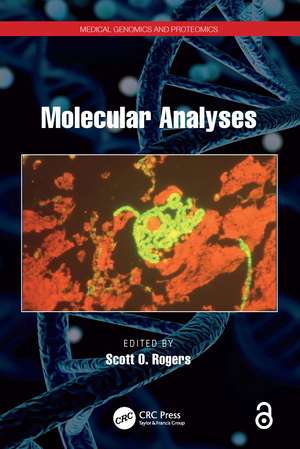Molecular Analyses: Molecular Genomics and Proteomics
Editat de Scott Orland Rogersen Limba Engleză Paperback – 26 aug 2024
Key Features
- Summarizes nucleic acid extractions from a wide variety of tissues and cells
- Describes processes of nucleic acid preservation
- Reviews forensic sampling, detection of nucleic acids, and delivery of nucleic acids to multicellular organisms
- Provides essential guidance for sequencing, sequence analysis, database searches, and phylogenetic analyses
- Includes additional methods useful for analysis of nucleic acids and proteins
DeSalle, et al. Phylogenomics: A Primer (ISBN 978-0-3670-2849-7).
Jennings, W. B. Phylogenomic Data Acquisition: Principles and Practice (ISBN 978-0-3678-6980-9).
Wang, X. Next-Generation Sequencing Data Analysis (ISBN 978-1-4822-1788-9)
Sung, W.-K. Algorithms for Next-Generation Sequencing (ISBN 978-0-3676-5797-0)
| Toate formatele și edițiile | Preț | Express |
|---|---|---|
| Paperback (1) | 438.89 lei 6-8 săpt. | |
| CRC Press – 26 aug 2024 | 438.89 lei 6-8 săpt. | |
| Hardback (1) | 983.38 lei 6-8 săpt. | |
| CRC Press – 11 iul 2022 | 983.38 lei 6-8 săpt. |
Preț: 438.89 lei
Nou
Puncte Express: 658
Preț estimativ în valută:
84.02€ • 86.41$ • 69.70£
84.02€ • 86.41$ • 69.70£
Carte tipărită la comandă
Livrare economică 20 februarie-06 martie
Preluare comenzi: 021 569.72.76
Specificații
ISBN-13: 9781032161907
ISBN-10: 1032161906
Pagini: 375
Ilustrații: 176
Dimensiuni: 156 x 234 mm
Greutate: 0.69 kg
Ediția:1
Editura: CRC Press
Colecția CRC Press
Seria Molecular Genomics and Proteomics
Locul publicării:Boca Raton, United States
ISBN-10: 1032161906
Pagini: 375
Ilustrații: 176
Dimensiuni: 156 x 234 mm
Greutate: 0.69 kg
Ediția:1
Editura: CRC Press
Colecția CRC Press
Seria Molecular Genomics and Proteomics
Locul publicării:Boca Raton, United States
Public țintă
Academic, Postgraduate, and ProfessionalNotă biografică
Scott Orland Rogers is a professor of molecular biology and evolution at Bowling Green State University, Bowling Green, Ohio. He received his PhD in plant molecular biology from the University of Washington, Seattle. He was an assistant professor and associate professor at the State University of New York College of Environmental Science and Forestry before moving to BGSU. He has taught courses in biology, botany, cell physiology, molecular biology, molecular genetics, bioinformatics, and molecular evolution. Research in his lab includes studies of microbes and nucleic acids preserved in ice, life in extreme environments, group I introns, molecular microbial phylogenetics, microbial metagenomics/metatranscriptomics, ancient DNA, and plant development.
Cuprins
Preface. List of Contributors. Nucleic Acid Extraction from Diverse Samples. DNA Extraction from Mummified Tissues. Commercial DNA Extraction Kits. Automated Nucleic Acid Extraction. Forensic DNA Samples: Collection and Handling. DNA Preservation. RNA Storage. Disposable Electrochemical DNA Biosensors. Handheld Nucleic Acid Analyzer. DNA-Binding Fluorophores. Fluorescence Resonance Energy Transfer (FRET). LightUp® Probes. Invader® Assay. Laser-Capture Microdissection. Helper-Dependent Adenoviral Vectors. Retroviral Vectors. Liposomal Nonviral Delivery Vehicles. Polymer-Based Nonviral Nucleic Acid Delivery and Genome Editing. Automated DNA Sequencing. DNA Sequencing Methods. Differential Sequencing by Mass Spectrometry. Brief Guide to Conducting Biological Database Searches. Accessing Genomic Databases. Phylogenetics, Comparative Genomics, and Phylogenomics. DNannotator: Annotation Software Tool Kit for Regional Genomic Sequences. ESTAnnotator: A Tool for High-Throughput EST Annotation. The Basics of Omics. Ribotyping. Forensic DNA Typing: Y Chromosome. Forensic Identification: An Overview on Molecular Diagnostic Technology. Denaturing Gradient Gel Electrophoresis (DGGE). Heteroduplex Analysis (HA). NEBcutter: A Program to Cleave DNA with Restriction Enzymes. Differential Display (DD) Analysis. Protein Truncation Test (PTT). Index.
Descriere
Methods for extraction, manipulation, and characterization of nucleic acids, peptides, and proteins have been rapidly developed. Extraction from a variety of tissues and samples have become routine and automated. Next generation sequencing (NGS) methods have been developed. This book focuses on medically-focused methods.

